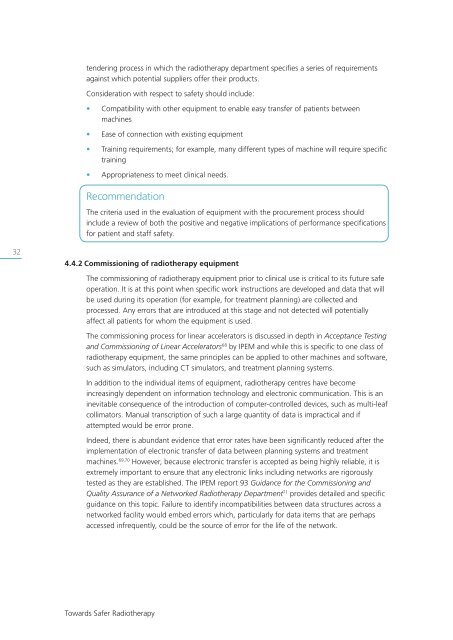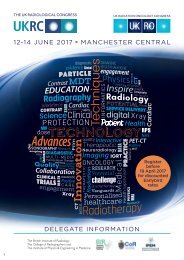Towards Safer Radiotherapy
Towards Safer Radiotherapy
Towards Safer Radiotherapy
You also want an ePaper? Increase the reach of your titles
YUMPU automatically turns print PDFs into web optimized ePapers that Google loves.
tendering process in which the radiotherapy department specifies a series of requirements<br />
against which potential suppliers offer their products.<br />
Consideration with respect to safety should include:<br />
• Compatibility with other equipment to enable easy transfer of patients between<br />
machines<br />
• Ease of connection with existing equipment<br />
• Training requirements; for example, many different types of machine will require specific<br />
training<br />
• Appropriateness to meet clinical needs.<br />
Recommendation<br />
The criteria used in the evaluation of equipment with the procurement process should<br />
include a review of both the positive and negative implications of performance specifications<br />
for patient and staff safety.<br />
32<br />
4.4.2 Commissioning of radiotherapy equipment<br />
The commissioning of radiotherapy equipment prior to clinical use is critical to its future safe<br />
operation. It is at this point when specific work instructions are developed and data that will<br />
be used during its operation (for example, for treatment planning) are collected and<br />
processed. Any errors that are introduced at this stage and not detected will potentially<br />
affect all patients for whom the equipment is used.<br />
The commissioning process for linear accelerators is discussed in depth in Acceptance Testing<br />
and Commissioning of Linear Accelerators 68 by IPEM and while this is specific to one class of<br />
radiotherapy equipment, the same principles can be applied to other machines and software,<br />
such as simulators, including CT simulators, and treatment planning systems.<br />
In addition to the individual items of equipment, radiotherapy centres have become<br />
increasingly dependent on information technology and electronic communication. This is an<br />
inevitable consequence of the introduction of computer-controlled devices, such as multi-leaf<br />
collimators. Manual transcription of such a large quantity of data is impractical and if<br />
attempted would be error prone.<br />
Indeed, there is abundant evidence that error rates have been significantly reduced after the<br />
implementation of electronic transfer of data between planning systems and treatment<br />
machines. 69,70 However, because electronic transfer is accepted as being highly reliable, it is<br />
extremely important to ensure that any electronic links including networks are rigorously<br />
tested as they are established. The IPEM report 93 Guidance for the Commissioning and<br />
Quality Assurance of a Networked <strong>Radiotherapy</strong> Department 71 provides detailed and specific<br />
guidance on this topic. Failure to identify incompatibilities between data structures across a<br />
networked facility would embed errors which, particularly for data items that are perhaps<br />
accessed infrequently, could be the source of error for the life of the network.<br />
<strong>Towards</strong> <strong>Safer</strong> <strong>Radiotherapy</strong>



